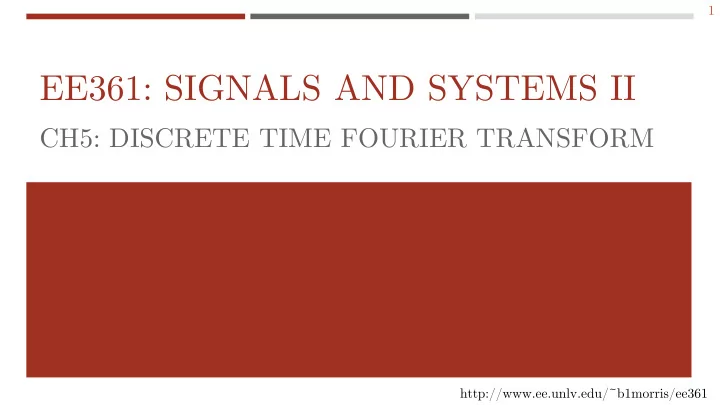

1 EE361: SIGNALS AND SYSTEMS II CH5: DISCRETE TIME FOURIER TRANSFORM http://www.ee.unlv.edu/~b1morris/ee361
2 FOURIER TRANSFORM DERIVATION CHAPTER 5.1-5.2
3 FOURIER SERIES REMINDER Previously, FS allowed representation of a periodic signal as a linear combination of harmonically related exponentials 𝑏 𝑙 = 1 𝑂 σ 𝑜=<𝑂> 𝑦 𝑜 𝑓 −𝑘𝑙𝜕 0 𝑜 𝑒𝑢 𝑦[𝑜] = σ 𝑙=<𝑂> 𝑏 𝑙 𝑓 𝑘𝑙𝜕 0 𝑜 2𝜌 𝜕 0 = 𝑂 Would like to extend this (Transform Analysis) idea to aperiodic (non-periodic) signals
4 DT FOURIER TRANSFORM DERIVATION Intuition (same idea as CTFT): Consider a finite signal 𝑦[𝑜] Periodic pad to get periodic signal 𝑦[𝑜] Find FS representation of 𝑦[𝑜] Analyze FS as 𝑂 → ∞ (𝜕 0 → 0) to get DTFT Note DTFT is discrete in time domain – continuous in frequency domain Envelope 𝑌(𝑓 𝑘𝜕 ) of normalized FS coefficients {𝑏 𝑙 𝑂} defines the DTFT (spectrum of 𝑦[𝑜] )
5 DT FOURIER TRANSFORM PAIR 1 2𝜌 𝑌 𝑓 𝑘𝜕 𝑓 𝑘𝜕𝑜 𝑒𝜕 synthesis eq (inverse FT) 𝑦[𝑜] = 2𝜌 𝑌 𝑓 𝑘𝜕 = σ 𝑜=−∞ ∞ 𝑦 𝑜 𝑓 −𝑘𝜕𝑜 analysis eq (FT) DTFT is discrete in time – continuous in frequency Notice the DTFT 𝑌(𝑓 𝑘𝜕 ) is period with period 2𝜌
6 DTFT CONVERGENCE The FT converges if absolutely summable σ 𝑜 𝑦 𝑜 < ∞ 2 < ∞ finite energy σ 𝑜 𝑦 𝑜 iFT has not convergence issues because 𝑌 𝑓 𝑘𝜕 is periodic Integral is over a finite 2𝜌 period (similar to FS)
7 FT OF PERIODIC SIGNALS Important property 𝑦 𝑜 = 𝑓 𝑘𝑙𝜕 0 𝑜 ↔ 𝑌 𝑘𝜕 = σ 𝑚=−∞ ∞ 2𝜌𝜀 𝜕 − 𝑙𝜕 0 − 2𝜌𝑚 Impulse at frequency 𝑙𝜕 0 and 2𝜌 shifts Transform pair σ 𝑙=<𝑂> 𝑏 𝑙 𝑓 𝑘𝑙𝜕 0 𝑜 ↔ 2𝜌 σ 𝑙=−∞ ∞ 𝑏 𝑙 𝜀 𝜕 − 𝑙𝜕 0 Each 𝑏 𝑙 coefficient gets turned into a delta at the harmonic frequency
8 DTFT PROPERTIES AND PAIRS CHAPTER 5.3-5.6
9 PROPERTIES/PAIRS TABLES Most often will use Tables to solve problems Table 5.1 pg 391 – DTFT Properties Table 5.2 pg 392 – DTFT Transform Pairs
10 NOTEWORTHY PROPERTIES Periodicity – 𝑌 𝑓 𝑘𝜕 = 𝑌 𝑓 𝑘 𝜕+2𝜌 Time shift – 𝑦 𝑜 − 𝑜 0 ↔ 𝑓 −𝑘𝜕𝑜 0 𝑌 𝑓 𝑘𝜕 Frequency/phase shift – 𝑓 𝑘𝜕 0 𝑜 𝑦 𝑜 ↔ 𝑌 𝑓 𝑘 𝜕−𝜕 0 Convolution – 𝑦 𝑜 ∗ 𝑧 𝑜 ↔ 𝑌 𝑓 𝑘𝜕 𝑍 𝑓 𝑘𝜕 1 2𝜌 𝑌 𝑓 𝑘𝜄 𝑍 𝑓 𝑘 𝜕−𝜄 Multiplication – 𝑦 𝑜 𝑧 𝑜 ↔ 𝑒𝜄 2𝜌 Notice this is an integral over a single period periodic convolution 1 2𝜌 𝑌 𝑓 𝑘𝜕 ∗ 𝑍 𝑓 𝑘𝜕
11 NOTEWORTHY PAIRS I Decaying exponential ℎ 𝑜 = 𝑏 𝑜 𝑣[𝑜] 𝑏 < 1 Magnitude response
12 DECAYING EXPONENTIAL 0 < 𝑏 < 1 −1 < 𝑏 < 0 Lowpass filter Highpass filter
13 NOTEWORTHY PAIRS II Impulse 𝑦 𝑜 = 𝜀[𝑜] ↔ 𝑌 𝑓 𝑘𝜕 = σ 𝑜 𝜀 𝑜 𝑓 −𝑘𝜕𝑜 = σ 𝑜 𝜀 𝑜 𝑓 −𝑘𝜕 0 = σ 𝑜 𝜀 𝑜 = 1 𝑦 𝑜 = 𝜀 𝑜 − 𝑜 0 ↔ 𝑌 𝑓 𝑘𝜕 = σ 𝑜 𝜀 𝑜 − 𝑜 0 𝑓 −𝑘𝜕𝑜 = σ 𝑜 𝜀 𝑜 − 𝑜 0 𝑓 −𝑘𝜕𝑜 0 = 𝑓 −𝑘𝜕𝑜 0 Rectangle pulse sin 𝜕 2𝑂1+1 𝑦 𝑜 = ቊ1 𝑜 ≤ 𝑂 1 ↔ 𝑌 𝑓 𝑘𝜕 = σ 𝑜=−𝑂 1 𝑓 −𝑘𝜕𝑜 = 𝑂 1 2 sin 𝜕 0 𝑜 > 𝑂 1 2 Periodic signal 𝑦 𝑜 = σ 𝑙=<𝑂> 𝑏 𝑙 𝑓 𝑘𝑙𝜕 0 𝑜 ↔ 𝑌 𝑓 𝑘𝜕 = 2𝜌 σ 𝑙=−∞ ∞ 𝑏 𝑙 𝜀 𝜕 − 𝑙𝜕 0 One period of 𝑏 𝑙 copied
14 DTFT AND LTI SYSTEMS CHAPTER 5.8
15 GENERAL DIFFERENCE EQUATION SYSTEM Solve for frequency response Take FT of both sides Rational form – ratio of polynomials in e −𝑘𝜕 Best solved using partial fraction expansion (Appendix A) Note special heavy-side cover-up approach for repeated root
16 LTI SYSTEM APPROACH Same techniques as in continuous case 𝑍 𝑓 𝑘𝜕 = 𝐼 𝑓 𝑘𝜕 𝑌 𝑓 𝑘𝜕 Partial fraction expansion Inverse FT with tables
Recommend
More recommend